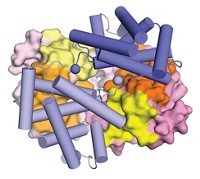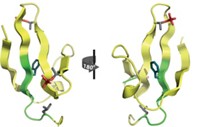Advertisement
Grab your lab coat. Let's get started
Welcome!
Welcome!
Create an account below to get 6 C&EN articles per month, receive newsletters and more - all free.
It seems this is your first time logging in online. Please enter the following information to continue.
As an ACS member you automatically get access to this site. All we need is few more details to create your reading experience.
Not you? Sign in with a different account.
Not you? Sign in with a different account.
ERROR 1
ERROR 1
ERROR 2
ERROR 2
ERROR 2
ERROR 2
ERROR 2
Password and Confirm password must match.
If you have an ACS member number, please enter it here so we can link this account to your membership. (optional)
ERROR 2
ACS values your privacy. By submitting your information, you are gaining access to C&EN and subscribing to our weekly newsletter. We use the information you provide to make your reading experience better, and we will never sell your data to third party members.
Protein Folding
Mutations switch folds in proteins
Computational approaches identify evolutionary link between proteins with different folds
by Celia Henry Arnaud, special to C&EN
June 13, 2023

A protein’s amino acid sequence helps determine its structure. Thus, proteins with similar sequences would be expected to have similar structures. But sometimes seemingly minor sequence changes can lead to big structural changes. For example, some amino acid substitutions can cause a protein fold to switch from an α-helix to a β-sheet or vice versa.
Lauren L. Porter of the National Institutes of Health and coworkers used computational approaches to show how such fold switching may have happened over the course of evolution in a family of about 600,000 bacterial response regulator proteins (Nat. Commun. 2023, DOI: 10.1038/s41467-023-38519-0). The C-terminal domains of all these proteins bind DNA. Some of the C-terminal domains have helix-turn-helix folds; others fold into an α-helix–β-sheet, also called a winged helix.
The researchers used phylogenetic analysis to determine how the proteins were related to each other and to identify evolutionary intermediates that could have served as bridge sequences between the two folds. They then used ancestral sequence reconstruction with AlphaFold2 models to show how sequence changes may have switched one structure to the other during evolution. The analyses consistently suggest that the helix-turn-helix occurred first and that stepwise mutations led to the winged helix.
Such an evolutionary order makes sense, Porter says, because the helix-turn-helix binds only to the major groove of DNA, whereas the winged helix binds to both the major groove and the minor groove. In addition, the last helix of the helix-turn-helix isn’t strongly conserved in the protein family, but the β sheet is.
“I believe that we will see many other cases of ‘evolutionary metamorphism’ in protein structures that appear to be formed by the mixing and matching of unrelated fragments,” Claudia Alvarez-Carreño, who studies protein evolution at the Center for the Origin of Life at the Georgia Institute of Technology, writes in an email. “We now have the tools and protocols to start uncovering these stories.”
Porter thinks that fold switching could have major implications for how researchers align proteins and how they think about protein families. “Most people just figure proteins in the same family have got the same fold. Well, that’s not always true. How not true it is we still don’t know,” she says. “The goal of my lab is to develop methods to be able to predict fold switching from genomic sequences.”




Join the conversation
Contact the reporter
Submit a Letter to the Editor for publication
Engage with us on Twitter